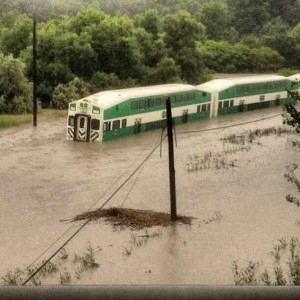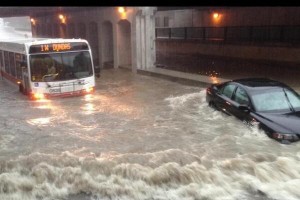
Flash-flooding halted train service in Toronto on Monday, July 8, 2013.
Is global flooding caused by urban sprawl, polar shifting, sea ice melting, or all of the above? Whatever the cause, much of our planet is underwater.
Toronto
According to Environment Canada, a slow moving cluster of thunderstorms with very heavy downpours produced localized flash flooding in the Greater Toronto area, July 8, 2013. By late Monday evening, 91 mm (3.5 inches) of rain fell in the city while rainfall totals measured 106 mm (4 inches) at the suburban Pearson International Airport after the storms blew east.
The rain began at 4 p.m. local time, stranding commuters in cars, buses and subway trains as the busy rush hour was getting underway.
This isn’t THAT much rain, so why did this sea of rainwater become so dangerous, so fast? The water had no where to go because of human development …
Urban Areas
Most present-day, devastating flooding occurs in the areas where humans should never build or concentrate the population; in areas that are too close to the shorelines, on flood plains, or along major rivers.
Expanding cities clear the trees, cement and pave over the porous soil, and reroute underground water channels to make way for our sewage. We dam natural rivers and build roads and housing developments where we should never build.
How much flooding are we bringing upon ourselves?

The streets of Toronto were rivers of water after a slow moving storm system dropped over 3.5 inches of rain into the urban area.
Flooding Around The World
- Paraguay
- Southeast USA
- Midwestern USA
- Guinea/Sierra Leone, Africa
- North Dakota
- Eastern Malaysia
- Malaysia Peninsular
- Argentina
- China
If you look at these areas on a map, you will see that these are the areas that have been over-developed, dammed, and concreted.
There are solutions, you know. Stop changing the natural landscape. Sprawling urban planning is in need of some serious revisions.
